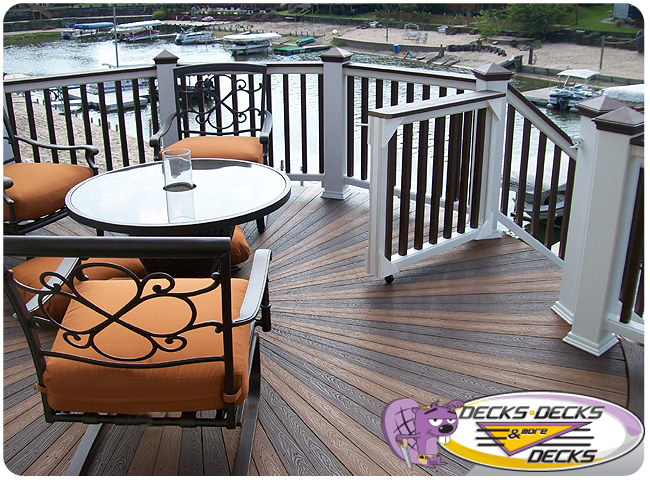What Is Diagonal Decking and Other Decking Patterns?
When designing a new deck, the pattern you choose for your decking can dramatically impact its appearance and functionality. Diagonal decking is one popular option among various patterns that can enhance the visual appeal of your outdoor space. Here’s a comprehensive guide to diagonal decking and other common decking patterns to help you make an informed decision for your home.
What Is Diagonal Decking?
Overview: Diagonal decking, also known as diagonal pattern decking, involves laying the deck boards at an angle to the frame of the deck. This pattern can create a visually interesting and dynamic look compared to traditional horizontal or vertical decking.
Benefits:
- Enhanced Visual Appeal: The diagonal pattern adds a sense of movement and flow to the deck, making it a focal point of your outdoor space.
- Illusion of Space: Diagonal decking can make a smaller area appear larger by drawing the eye across the space.
- Stronger Structure: Diagonal boards can help distribute weight more evenly, potentially providing better structural stability.
Considerations:
- Increased Material Waste: Cutting boards at an angle can result in more waste, which might increase material costs.
- Higher Installation Costs: The complexity of the pattern can make installation more labor-intensive and expensive.
Common Decking Patterns
In addition to diagonal decking, several other patterns can transform the look of your deck. Here are some popular options:
1. Horizontal Decking
Overview: Horizontal decking is the most traditional and commonly used pattern, where the boards run parallel to the house.
Benefits:
- Classic Look: Provides a straightforward, timeless appearance that complements many home styles.
- Easy Installation: Generally simpler to install compared to more complex patterns.
- Efficient Use of Materials: Minimal waste due to straightforward cuts.
Considerations:
- Standard Appearance: May lack the unique visual impact of more intricate patterns.
2. Vertical Decking
Overview: Vertical decking involves installing the boards perpendicular to the house, running parallel to the deck’s edges.
Benefits:
- Modern Look: Offers a sleek and contemporary appearance.
- Visual Height: Can make the deck appear taller, which may be beneficial for decks that are elevated or have a lower height.
Considerations:
- Limited Use: Less common than horizontal decking, which might not suit all design aesthetics.
3. Herringbone Decking
Overview: Herringbone decking is a pattern where boards are laid in a V-shaped pattern, creating a distinctive and elegant look.
Benefits:
- Unique Appearance: The pattern adds a sophisticated and high-end look to your deck.
- Visual Interest: Creates a dynamic and engaging visual effect.
Considerations:
- Complex Installation: Requires precise cuts and alignment, which can increase installation time and cost.
- Higher Material Waste: The pattern can lead to more waste due to angled cuts.
4. Basketweave Decking
Overview: Basketweave decking features boards arranged in a grid-like pattern, creating a woven effect.
Benefits:
- Stylish Design: Offers a unique, eye-catching look that stands out from standard patterns.
- Customizable: Allows for creative combinations of board colors and sizes.
Considerations:
- Detailed Work: Requires careful planning and precise execution to achieve the desired effect.
- Increased Costs: Both installation and material costs may be higher due to the complexity of the pattern.

5. Chevron Decking
Overview: Chevron decking involves boards arranged in a zigzag pattern, with each board forming a V shape.
Benefits:
- Dynamic Look: Provides a bold and modern appearance that can make a strong statement.
- Visual Movement: Creates a sense of movement and flow on the deck.
Considerations:
- Precision Required: Requires careful measurement and cutting to maintain the pattern’s alignment.
- Higher Costs: Due to the complexity of installation and cutting, the overall cost can be higher.
Choosing the Right Pattern for Your Deck
When selecting a decking pattern, consider the following factors:
- Aesthetic Preferences: Choose a pattern that complements your home’s style and your personal taste.
- Budget: Some patterns may be more expensive due to increased material waste or installation complexity.
- Functionality: Consider how the pattern will affect the deck’s functionality and visual flow.
Conclusion
Diagonal decking and other patterns offer a range of options to enhance the visual appeal of your outdoor space. Whether you prefer the classic look of horizontal decking or the sophisticated design of herringbone or chevron patterns, each choice can bring a unique character to your deck. By understanding the benefits and considerations of each pattern, you can make an informed decision that aligns with your style and budget.
For expert guidance and professional installation, contact Decks, Decks, and More Decks. Our team can help you select and implement the perfect decking pattern for your home.

